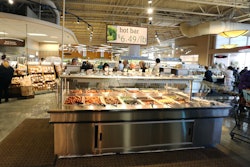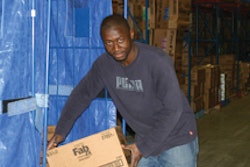
When public refrigerated warehouse (PRW) and refrigerated transport operators survey the frozen and refrigerated food landscape, they see challenges on all sides.
Consumer demand for frozen and refrigerated foods is strong, but the cold supply chain operators face pressures from processors and manufacturers who want to reduce inventories and move goods more quickly.
And with their own operating costs on the rise, it would seem rate increases for the cold logistics providers could be justified, but telling their manufacturer customers they must pay more in a severely depressed economic climate is hard to pull off.
Driving efficiencies in the cold chain helps keep everyone on the same page. If PRWs and cold transportation providers can wring more efficiencies out of the system, they enhance value for their own bottom lines and those of their customers.
“The general trend in the industry is to trim costs and take waste out of the system; to not do what you’ve done in the past,” says Mark Petersen, general manager, C.H. Robinson Worldwide Inc., Eden Prairie, MN.
Unlike hard goods, the food industry must work within seasonal constraints. “For perishable foods, there are supply adjustments necessary to get products closer to consumption,” says Petersen.
Perishability creates its own demand cycles, on top of the ongoing demands that “people will eat. Food is going to move one way or another,” he says.
The current economy drives efficiencies too. “We’re seeing a short-term planning approach with rationalization for getting the SKU base down,” says Richard Kappmeier, senior vice president of engineering, transportation and Western Region U.S. operations, VersaCold Logistics Services, Vancouver, BC.
Manufacturers and retailers are looking to eliminate the slow movers from their product assortments, says Kappmeier.
Cold chain providers have a particularly keen perspective on the pulse of the food industry as they move and store goods for vendors who work with both foodservice and grocery retail customers. They are definitely seeing a downturn on the foodservice side of the business and some notable shifting within the grocer sector, where consumers are moving to lower price points in the various frozen and refrigerated categories.
“We have found that the foodservice side is softer with consumers moving toward value players like McDonald’s and away from higher-priced restaurant chains,” says Bill Hudson, president and CEO, Global Cold Chain Alliance (GCCA), Alexandria, VA. “With people eating out less, customer business is down.”
Don Schoenl, president and CEO, Nordic Cold Storage, Atlanta, agrees. “We are seeing a decrease in volume in foodservice in general, but we’re seeing a pickup in retail volume.”
Overall, the economy is impacting what products are being stored in cold storage facilities. “Several of our members store seafood, and because it is a high price item, it may be more affected by the downturn,” says Hudson.
While higher price items are on the decline, other products are picking up. “Private label products are growing at a fast pace,” he points out. “We are seeing more frozen private label and frozen national brands of prepared foods going to retail.”
So there are pockets of optimism, says Hudson, but overall “customers are concerned and that could be translating into lower volumes for our member companies.”
REDUCING TOUCHES
Maintaining—and enhancing—efficiencies in the cold supply chain then becomes even more important. Across the board, both warehousing and transportation executives say reducing touch points is imperative.
“When you increase touches, you increase costs,” says Nordic’s Schoenl.
“With the reduced credit lines and the overall desire to shrink inventories and increase throughput, we are able to show our customers that we are making an investment in them and that we are efficient,” he says.
That investment is evident on two levels: technology and infrastructure. Nordic made a multimillion investment in its information technology (IT) support services by acquiring Red Prairie, a warehouse management system (WMS), and developing labor management and transportation management systems.
Nordic has 13 distribution centers throughout the Southeast. Two-thirds of its business is grocery retail and one-third foodservice, and among its customer base are chicken and turkey producers. These companies account for considerable volume for both retail and foodservice customers, but they also have a significant export business.
Much of that export business is handled through ports in New Orleans and Wilmington, NC. Noting the number of major poultry processors in the Carolinas and Virginia, Nordic has opened a facility in Wilmington, NC, to further support that business and the import-export needs of other customers.
The Port of Wilmington has good potential for business growth for Nordic as “it is picking up considerable business because of the congestion in other, more established ports,” says Schoenl.
Energy costs and sustainability are also driving change in the PRW industry.
“Green is still big and still comes with a price,” says Hudson. “New energy efficient technologies usually come with an ROI of 18 months or less. We are seeing energy savings come from lights, battery systems, doors and new technologies on refrigeration systems.”
“Energy is our second highest cost with labor being the highest,” says VersaCold’s Kappmeier. “We have made improvements throughout all of our facilities from simple things like door management to new, high-efficiency lighting systems and high-efficiency refrigeration systems.
“Overall, we avoided kilowatt hours by 22 million and were able to offset to a great extent the more frequent and high utility rate increase suffered in 2008,” he says. This was particularly significant as energy costs had increased, in some areas, 30 percent last year.
| GROSS REFIGERATED SPACE | CUBIC FEET |
| 1. AmeriCold Logistics LLC | 509,619,658 |
| 2. VersaCold Group (an Eimskip company) | 414,395,998 |
| 3. Millard Refrigerated Services | 275,000,000 |
| 4. Preferred Freezer Services | 186,250,625 |
| 5. United States Cold Storage | 161,792,447 |
| 6. Burris Refrigerated Logistics | 72,396,960 |
| 7. Interstate Warehousing Inc. | 68,402,968 |
| 8. Nordic Cold Storage LLC | 60,143,000 |
| 9. Inland Cold Storage | 57,461,576 |
| 10. Cloverleaf Cold Storage Co. | 52,231,973 |
| 11. Total Logistic Control LLC | 49,003,066 |
| 12. Columbia Colstor Inc. | 47,600,000 |
| 13. Richmond Cold Storage Co. | 44,657,281 |
| 14. Henningsen Cold Storage Co. | 42,589,635 |
| 15. Frialsa Frigorificos S.A. de C.V. | 34,303,927 |
| 16. Hanson Logistics | 32,496,430 |
| 17. Terminal Freezers Inc. | 25,938,138 |
| 18. Confederation Freezers | 25,630,000 |
| 19. Conestoga Cold Storage | 25,610,000 |
| 20. Congbec Logistics Inc. | 23,850,000 |
| Total North American Top 20 Space | 2,209,373,682 |
| Source: International Association of Refrigerated Warehouses (IARW), Alexandria, VA. |


















